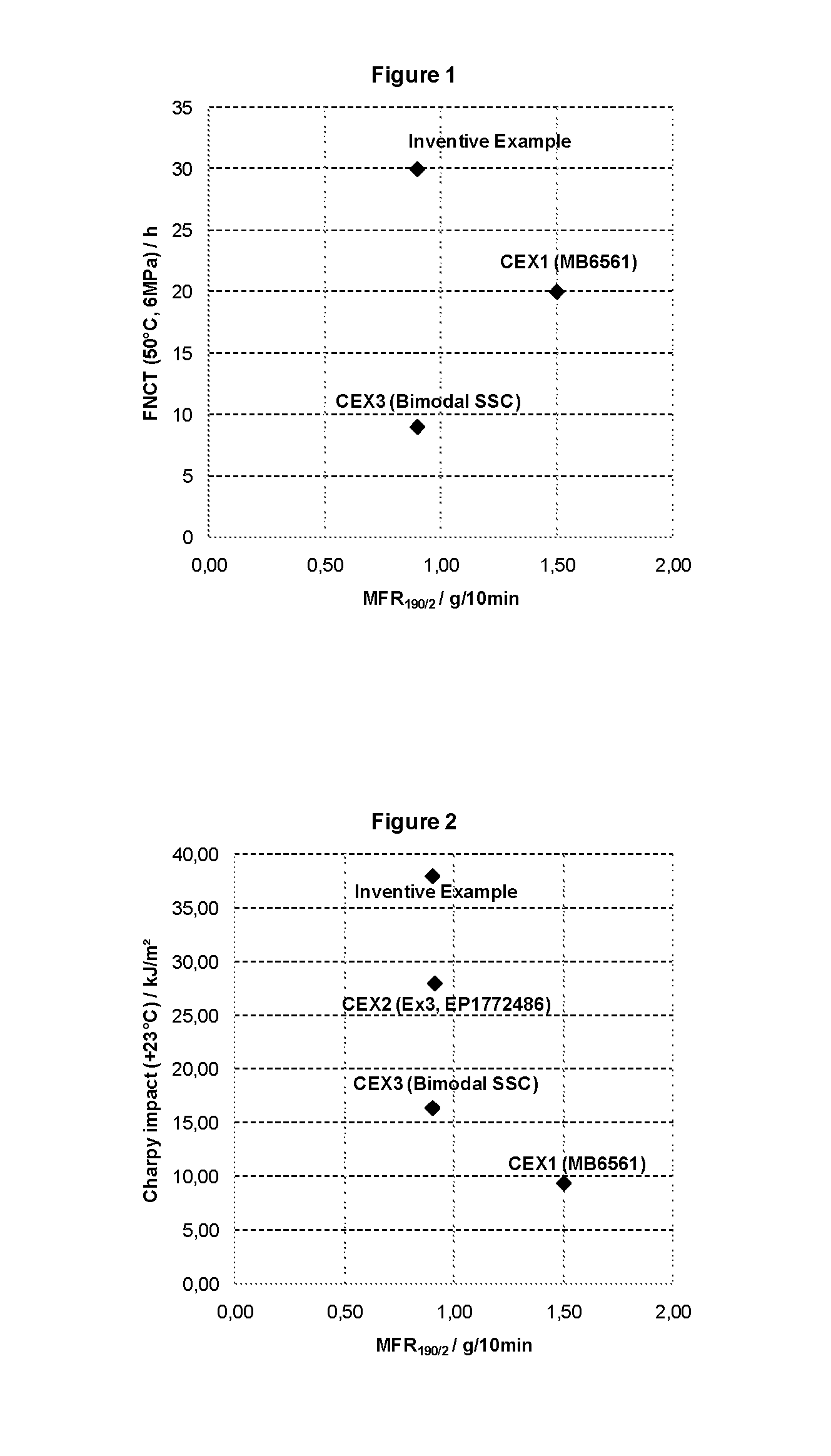Polyethylene moulding composition with improved stress crack/stiffness relationship and impact resistance
a technology of stress crack/stiffness relationship and polyethylene, which is applied in the field of polyethylene moulding composition, can solve the problems of impact resistance and escr, decrease, and decrease of processability, and achieve the effect of high density
- Summary
- Abstract
- Description
- Claims
- Application Information
AI Technical Summary
Benefits of technology
Problems solved by technology
Method used
Image
Examples
experimental and examples
1. Definitions and Measurement Methods
GPC: Molecular weight averages, molecular weight distribution, and polydispersity index (Mn, Mw, MWD, PDI)
[0130]Molecular weight averages (Mw, Mn), Molecular weight distribution (MWD) and its broadness, described by polydispersity index, PDI=Mw / Mn (wherein Mn is the number average molecular weight and Mw is the weight average molecular weight) were determined by Gel Permeation Chromatography (GPC) according to ISO 16014-4:2003 and ASTM D 6474-99. A Waters GPCV2000 instrument, equipped with differential refractive index detector and online viscosimeter was used with 2×GMHXL-HT and 1×G7000HXL-HT TSK-gel columns from Tosoh Bioscience and 1,2,4-trichlorobenzene (TCB, stabilized with 250 mg / L 2,6-Di tert butyl-4-methyl-phenol) as solvent at 140° C. and at a constant flow rate of 1 mL / min. 209.5 μL of sample solution were injected per analysis. The column set was calibrated using universal calibration (according to ISO 16014-2:2003) with at least 15 n...
example 2.1
Metallocene Complex Preparation
[0156]The catalyst complex used in the polymerisation examples was bis(n-butyl cyclopentadienyl)hafnium dibenzyl, (n-BuCp)2Hf(CH2Ph)2, and it was prepared according to “Catalyst Preparation Example 2” of WO2005 / 002744, starting from bis(n-butyl cyclopentadienyl)hafnium dichloride (supplied by Witco).
[0157]The catalyst preparation was made in a 160 L batch reactor into which a metallocene complex solution was added. Mixing speed was 40 rpm during reaction and 20 rpm during drying. Reactor was carefully flushed with toluene prior to reaction and inertized with nitrogen after silica addition
example 2.2
Preparation of Catalyst Composition
[0158]10.0 kg activated silica (commercial silica carrier, XP02485A, having an average particle size 20 μm, supplier: Grace) were first slurried into 21.7 kg dry toluene at room temperature. Then the silica slurry was added to 14.8 kg of 30 wt % methylalumoxane in toluene (MAO, supplied by Albemarle) during 3 hours. Afterwards the MAO / silica mixture is heated to 79° C. for 6 hours and then cooled down to room temperature again. The resulting solution was reacted with 0.33 kg of (n-BuCp)2Hf(CH2Ph)2 in toluene (67.9 wt %) for 8 hours at room temperature. The catalyst was dried under nitrogen purge for 5.5 hours at 50° C. The obtained catalyst had an Al / Hf mol-ratio of 200, an Hf-concentration of 0.44 wt % and an Al-concentration of 13.2 wt %.
3. Polyethylene moulding composition
PUM
| Property | Measurement | Unit |
|---|---|---|
| density | aaaaa | aaaaa |
| molecular weight distribution | aaaaa | aaaaa |
| density | aaaaa | aaaaa |
Abstract
Description
Claims
Application Information
 Login to View More
Login to View More - R&D
- Intellectual Property
- Life Sciences
- Materials
- Tech Scout
- Unparalleled Data Quality
- Higher Quality Content
- 60% Fewer Hallucinations
Browse by: Latest US Patents, China's latest patents, Technical Efficacy Thesaurus, Application Domain, Technology Topic, Popular Technical Reports.
© 2025 PatSnap. All rights reserved.Legal|Privacy policy|Modern Slavery Act Transparency Statement|Sitemap|About US| Contact US: help@patsnap.com

